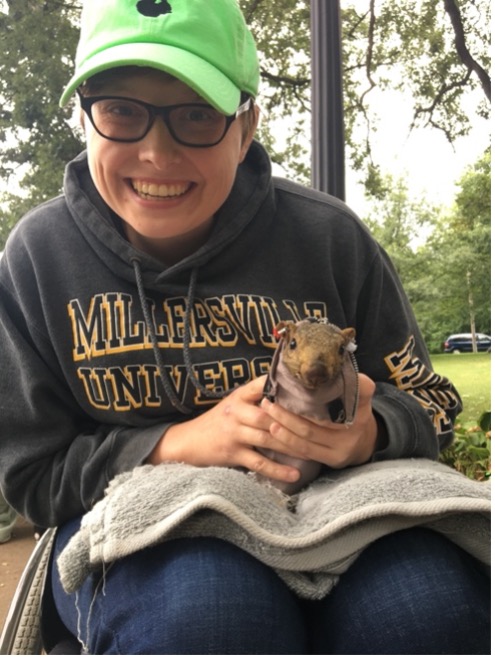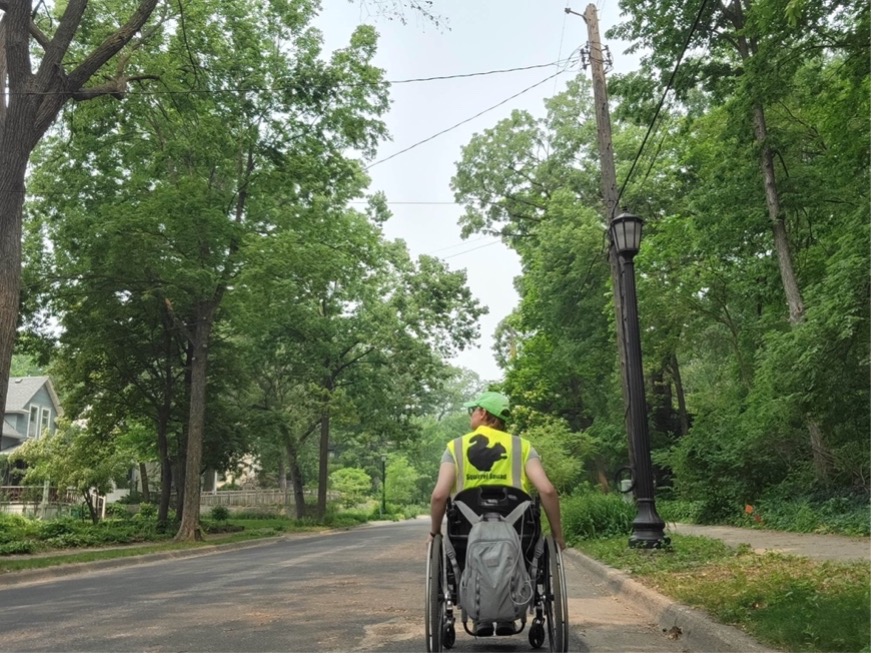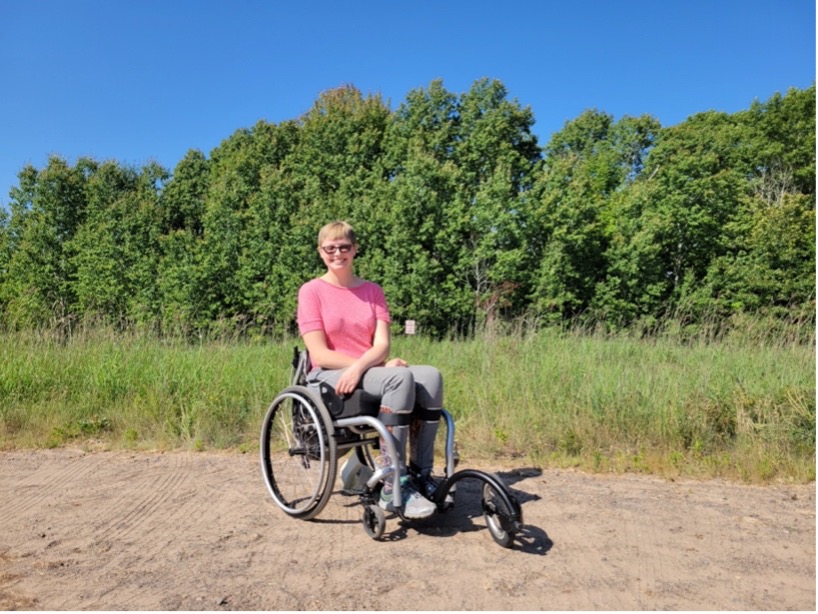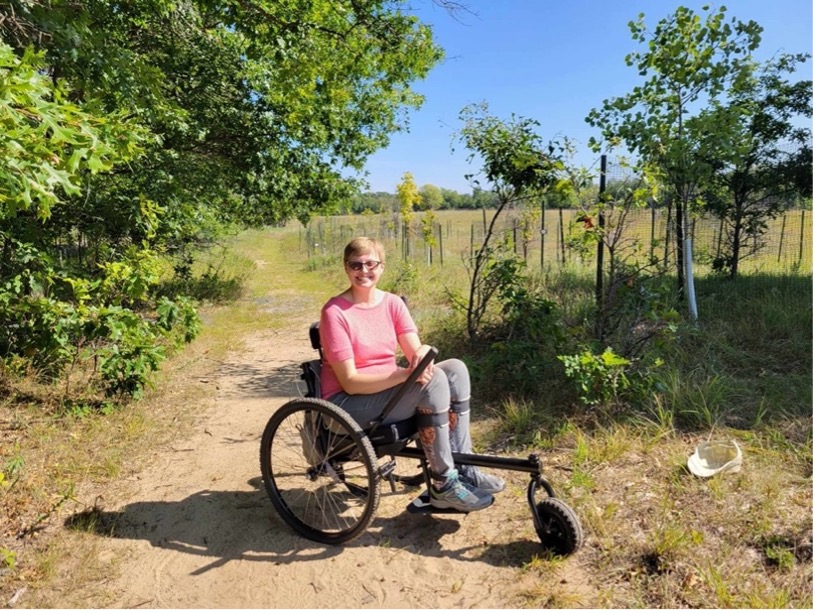By Charlotte Devitz, PhD Student with University of Minnesota College of Biological Sciences and the MSP LTER Urban Contaminants Team
As ecologists, we have the privilege of working in some pretty incredible places. Despite their beauty and the opportunities these environments provide us for research, these places are also not equally accessible to all. Natural environments pose a range of barriers to people with disabilities, and historically there have been significant gaps in both the efforts made and solutions available for making these environments more accessible. So how can we approach access challenges in the field? And why should we care? These are topics I never expected I would become such a passionate advocate for. Shortly after finishing my undergraduate degree, years of worsening health problems led to the diagnosis of an incurable and progressive genetic disorder. In the space of a few years, I lost a lot of mobility, and with it my aspirations of becoming a field scientist; I had never seen a field scientist with a disability, much less one who used a wheelchair. How could I study wildlife in environments I could not physically access?


Photos of Charlotte conducting her field research on squirrels in the Metro Area. You can learn more about Charlotte's research here. Photos by Charlotte Devitz and her field research team.
It has only been in the last decade or so that the scientific community has really begun to recognize its lack of accessibility, and this is perhaps why many—myself included—often feel out of place in field research environments. I am the first to acknowledge that navigating the complexities of improving accessibility is not always easy; but change for the better rarely is. Disability is nuanced and individuals’ access needs are unique, so where do we start? One of the simplest approaches is leveraging solutions that already exist by way of adaptive devices. Broadly defined, adaptive devices are tools that enable a disabled individual to carry out tasks; in the context of field work, these can range from simple things like modified grips for handheld tools to high-tech mobility devices equipped to handle rugged terrain.
There is a wealth of existing solutions that have improved the ability of disabled individuals to work and participate in outdoor recreation for decades; so why is accessibility in field science lagging so far behind?
One of the biggest barriers is funding. Even basic devices can be several hundred dollars, with more specialized or complex equipment costing up to $25,000—hardly a possibility for most people, especially early career scientists on graduate or post-doctoral student incomes. For an individual trying to acquire this type of equipment, even securing funding at a lab or departmental level can be challenging. If it is seen as “only” benefitting one individual, it can be difficult to justify the expenditure. Pushing for this type of equipment also requires “outing” one’s disabilities, and many, justifiably, might not wish to disclose this information with colleagues or superiors. On top of the existing stressors of navigating academia with a disability, advocating for the purchase of adaptive equipment may simply be a battle they choose not to fight, even if they would benefit from it.
So how can we get this type of equipment into the hands of those who need it in the least intrusive and most cost-effective manner possible? This is where an Equipment Repository for Accessibility or ERA comes in.
The concept is relatively simple: create a centralized repository of adaptive equipment that operates outside of standard university accommodations systems and provides a route for individuals to access this equipment for field-based courses and research. It transfers the burdens of both the equipment cost and navigating the logistics to acquire these items to a central entity that is able to draw upon numerous funding sources and meet field-based accessibility needs as they arise.

Charlotte with the FreeWheel Wheelchair Attachment (above)—an off-roading attachment for an individual’s personal manual wheelchair. Photo by Caitlin Potter.

Charlotte with the GRIT Freedom Chair (above)—a type of all-terrain manual wheelchair. Photo by Caitlin Potter.
I have worked alongside MSP LTER researcher and University of Minnesota Professor Emilie Snell-Rood to secure the initial funding needed to establish one such repository for the use of researchers in the College of Biological Sciences and beyond. To date, we have acquired two types of adaptive mobility devices available for field work (see above images of the GRIT Freedom Chair and the FreeWheel Wheelchair Attachment), and have been working to establish an extension of the repository explicitly for use at the Cedar Creek Ecosystem Science Reserve. In the future, we plan to seek out funding to purchase equipment to benefit individuals with a broader range of access needs and hope to see this concept spread to other universities and research institutes.
People with disabilities have so much to offer the scientific community, and a lack of access to or the costs of adaptive devices should not be the reason that these individuals cannot engage fully in field research.